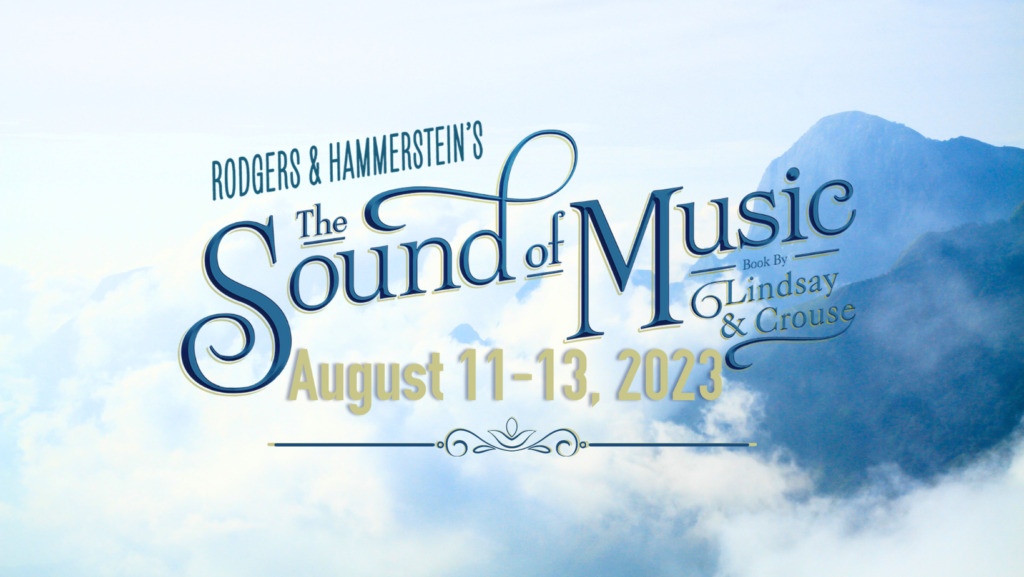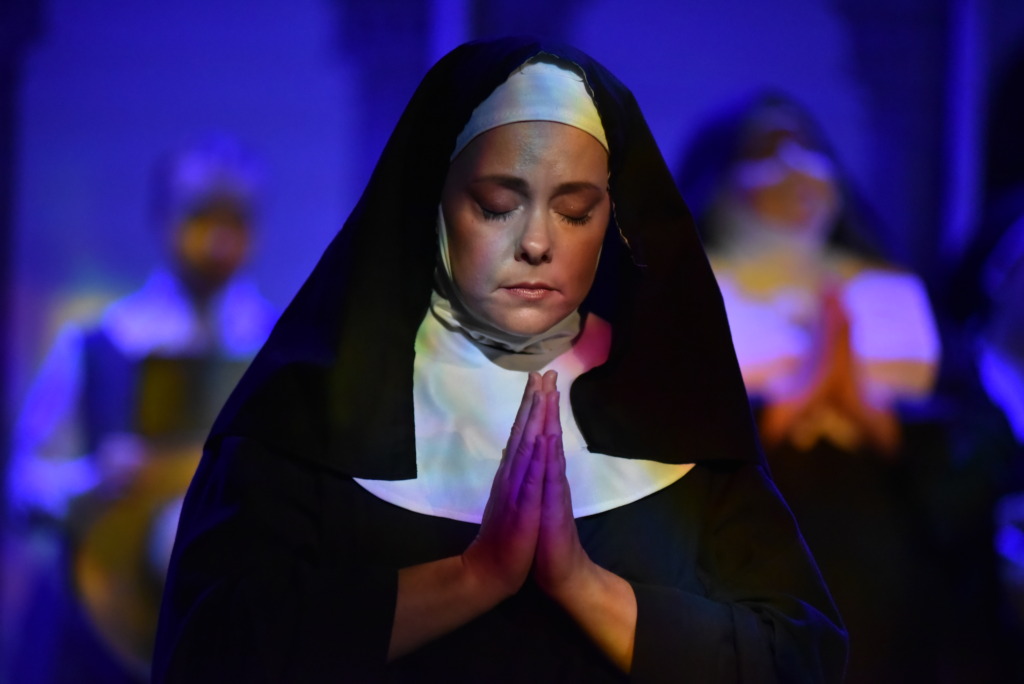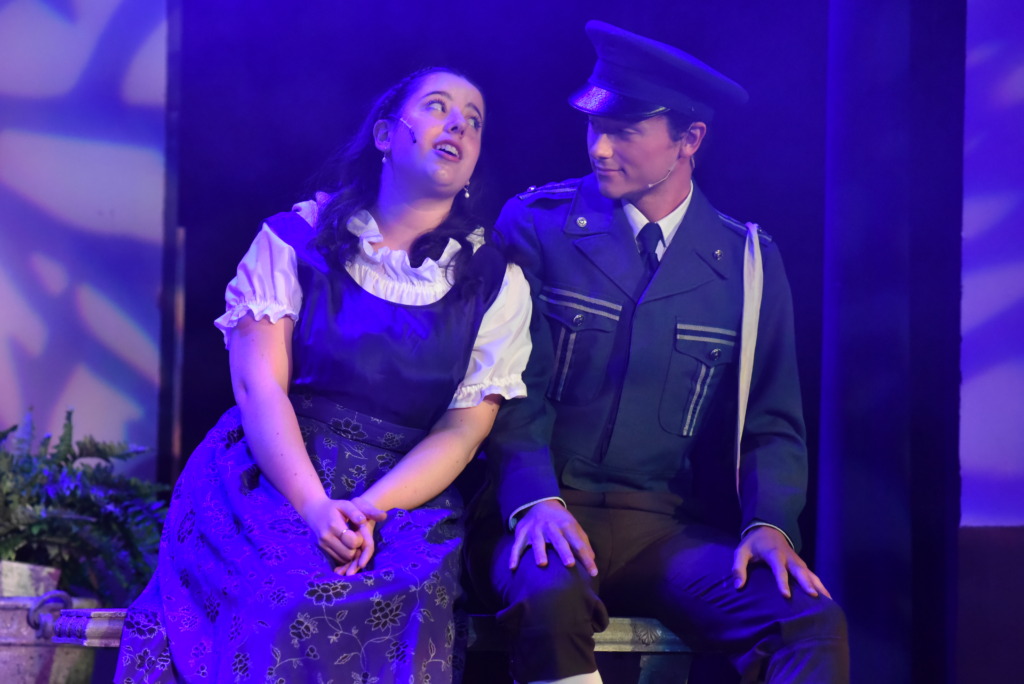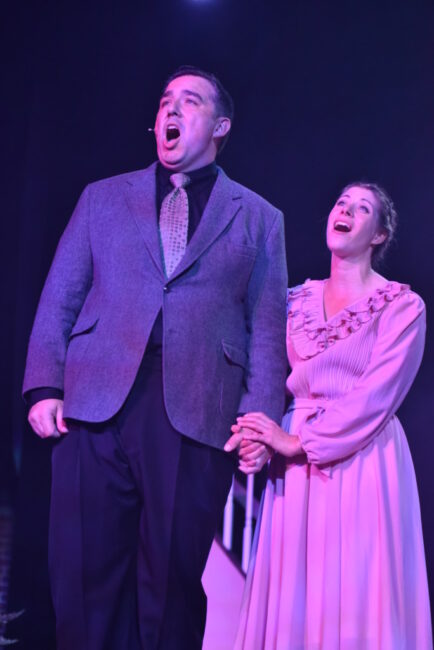I have confidence in musicals! I have confidence in rain. I have confidence that September Song will get to play again! And play again they did (despite the rain’s best efforts!) after a live-theatre hiatus, September Song Musical Theatre has returned to the stage their much-anticipated production of Rogers & Hammerstein’s The Sound of Music. And no storm or last minute venue-change is going to hold them back. Directed by Stephen Strosnider with Musical Direction by Kelly Stoneberger and Choreography by Amy Appleby, this is a truly delightful production of a well-worn classic.

There appear to be two categories, with no middle-ground, when it comes to this particular Rogers & Hammerstein chestnut: you love it; you hate it. For those of you that hate it (a category to which I generally subscribe) I strongly urge you to reconsider if only for September Song’s current production. There’s doing something extraordinary and refreshing. Director Stephen Strosnider has put vision into his vision, created a wondrous exploration of depth in characters from principal to tertiary and back, and has encouraged honest-to-God acting in addition to the musical components of this production. It’s something that all too often seems to be lacking in these ‘classics of their time’ as of late but Strosnider dives into the story, finds character arcs, rearranges some of the musical numbers (within the purview of the show’s licensing) and makes some judicious decisions about how to keep the show’s pacing moving. (It’s an R&H so it’s still going to come close to that three-hour marker, but you certainly don’t notice it with this production.)
While the set was undergoing some last-minute reconstruction (being emergently transferred and rescaled from a space twice the size due to the storm that ravaged Westminster), what was on stage at the final, invited dress was inspiring. A fully-functioning, rotating set of walls to transition from inside the Abby and the Von Trapp household to the outside mountains and other outdoor locations. There was even a picture of the then-current Pope (leaning but to be mounted) against the wall of the Abbey interior. The staircase (an integral part of any Sound of Music) as well as the bed for Maria’s room inside the Von Trapp household, and other delicate furnishings were all present and fully utilized. Not minimalist but not furniture as décor; everything in Set Designer Jim Stoneberger’s collection was purposeful. The glorious rolling hills of Austria (though not yet reaffixed to the rotating walls) were painted with resplendence by Scenic Artist Emme McCurry and will be the perfect touch to complete the visionary scenery once the enormous construct is reassembled in its entirety. It is not small feat to switch venues at the last moment and attempt to reconstruct a massive set to not only fit the smaller, more condensed stage, but still function fully as intended. September Song has done a superb job in tackling this challenge thus far, and truly given new meaning to “the show must go on.”

Corey Brown, responsible for the show’s Sound and Lighting Design, has found a striking balance with both design elements in this production. Colorful hues meant to represent stained glass glow down from above whenever the scenes in the Abbey come into play. Brown also uses subtle bursts of hazy pinks whenever the more romantic numbers are being sung on stage. If there’s one question to be had about Brown’s choice in lighting it’s the way he goes about lighting the Katlzberg Festival. While the floor-lamps do as intended, without an over-spot or follow-spot, the Von Trapp family look a bit look ghoulish zombies whilst performing, though perhaps this is the intent, to drive home that the happy faces they’re singing with isn’t really what’s happening for them emotionally. This odd choice aside, both the lighting design and Brown’s subtle use of fixed sound effects— the church bells, the chirping birds, the air-raid sirens as the Von Trapp adults are returning from their honeymoon— are strategically placed and executed, enhancing the show’s overall aural experience.
Costume Designer Andrew Malone has picked solid pieces for everyone in the performance, hinting at rather than overstating both time and place. When we initially encounter the Von Trapp children they are in their little naval-inspired uniforms. Malone keeps it simple, though gets a chance to exercise his opulence-muscle when it comes to outfitting Elsa Schraeder. Everything that graces that character by way of costume is decadent indulgence, from the white, glimmering almost Eva-Peron-esque ensemble to the gorgeous dripping emerald-shaded evening gown; it’s a striking contrast to the simpler garments worn by Maria. And Malone follows the overall continuity of things in his sartorial selections. You see a new postulant arriving at the Abbey when Maria first returns and she’s wearing a hideodeous clam-pink thing with fluff-ruffles around the collar. When Maria returns to the Von Trapp household at the top of the second Act? Same revolting pepto-pink-dress. And the children’s ‘play-clothes’ match the curtains in Maria’s room. (It’s far too often that these little nuanced details are overlooked when it comes to this production so it’s truly nice to see them being adhered to with September Song.)
What makes this production truly stand out is the way that Director Stephen Strosnider has framed it. There are all of these subtle moments that really heighten the overall experience and in many cases just make the show as a whole make much more sense. In the opening “Preludium”, you’re treated to the Mother Abbess singing alone in prayer, when Maria (silently) approaches in giddy glee and you get to watch this silent exchange whilst Maria, somewhat impatiently waits for her to finish so she can have a whispered exchange with her. Why? Because it’s Maria asking permission to leave the Abbey for the day (the whole catalyst for “How Do You Solve a Problem Like Maria?”) and it’s brilliant. Little moments like this— Elsa physically seeing and silently responding with drastic facial expressions, the act of Georg and Maria dancing together and things like that. But it’s more than just these moments Strosnider has incorporated into the production, it’s what he’s taken out, re-arranged, and shifted. There’s no preening scene just before she gets married, which is an excellent way to render the essence of the Von Trapp marriage in an already lengthy Rogers & Hammerstein work.

And he’ moved some of the song around (everything is still there just perhaps not quite where you remember it.) When the children storm into Maria’s room during the storm? They sing “My Favorite Things” because it’s a song to help them not feel scared, so that when they sing it again at the top of Act II before Maria returns it makes so much more sense. Maria takes the children into the village on a little parade midway through “Do-Re-Mi”, which transforms the back-half of this number into a singing, dancing festival among the villagers and it just makes so much more sense as a rowdy, giddy, good-time full-ensemble number. Don’t worry, “The Lonely Goatherd” makes a reappearance, first as the silly song that the children are singing wit Max at the top o the second act, but because of that instance (and the little marionette goat puppet the children are playing with) it quickly becomes the— dare I say it— scapegoat for the scene with Frau Zeller, when she demands to know what they will sing. And Maria picks up the puppet and starts a verse, forcing George to join in. It’s just brilliant the way that tumbles into the Festival performance, featuring the children singing along with them.
Musically the show is perfection. Musical Director Kelly Stoneberger has masterfully brought performers of all ages together to create these incredible sounds in all of these beloved Rogers & Hammerstein tunes. Yes, you need good music and raw talent, but there’s just something about the blending and clarity of harmonies that Stoneberger has put forth that makes this production truly extraordinary. Particularly when the nuns are singing both at the top of act one in “Preludium” an the “Wedding Processional” in the second act, where the sounds of these sisters is haunting, lusty and religious, almost as if you’re in a high church somewhere. (And kudos to Corey Brown for knowing when to add that reverb-effect to solo-nun-mics creating the illusion that they’re singing inside an acoustically perfect sanctuary.) Even the young children find their pitches and maintain them during “Do-Re-Mi” and “The Sound of Music (Reprise).” Worthy too of praise is the show’s choreographer, Amy Appleby. While The Sound of Music isn’t often perceived as a heavily choreographed show, because of the way Director Steven Strosnider has altered the performance, there’s now ample opportunity for group dancing, particularly during “Do-Re-Mi” and it’s just gleeful. Appleby keeps the moves simple but fun, clean and effective, and finds a routine that allows for the ensemble to move with energy without appearing to be overcrowded on the stage. She also has a good handle on how not to overchoreograph the show, which is an earnest concern when it comes to shows that do not readily lend themselves to big dance numbers.
The ensemble (Hannah St. Michel, Elsa Nowicki, Emily Kranking, Grace Kleinschmidt, Max Hansborough, Joe Hansbrough, Sophie Arnold) is small in numbers but mighty in presence, varying from villagers to party guests and quite a few in-between, with some of the ensemble doubling up as those featured at the Festival, or as in the case of Sara Butler, as raging Nazi bulls. Butler is hell on wheels as she barks at the Von Trapps, demanding this and that; it’s quite frightening. The Nun Ensemble (Jen Stavrakis, Ariana Satre, Rachel Miller, Danielle Rizzo, Erica Hansbrough, and the aforementioned Sara Butler) as well as the Postulant Ensemble (Meghan Brown, Jessica Little, Claire Mattingly, Ronni Snyder) do create some of the most glorious sounds with their blending voices, particularly during “Morning Hymn” and “Preludium.” The nuns also all appear as villagers and party guests, some even appearing as villaging-nuns, which makes Maria out in the village with the children during “Do-Re-Mi” an extra-special treat as some of the nuns recognize her and get greeted in surprise with a hug from her.

Sister Sophia (Sharon Warner), Sister Margaretta (Casey Golden), and Sister Berthe (Patti DiLeonardi) have quite the personalities among them, and they are most readily displayed during “How Do You Solve a Problem Like Maria?” Warner, Golden, and DiLeonardi have a fine handle on how to sing this number with their respective character attitudes; they become more than just the three nuns in the office with Mother Abbess. And again, in one of Strosnider’s ‘little touches’, as Maria leaves the office for her commission to the Von Trapp household, one of said sisters tumbles through the door to the floor, making it very obvious that they were all eavesdropping on the incident. The Mother Abbess (Annette Larsen) has an exquisite voice, something truly operatic in quality and sounds as if she’s had training of an operatic nature as well. The glorious, heavenly sustain she delivers at the end of “Climb Every Mountain” could easily surpass the rafters straight into heaven. But what’s even more noteworthy about Larsen, beyond her stellar voice, is her warm and bubbly nature. She’s kind and compassionate, almost like caring Granny, as if many, many moons ago she too could have been a ‘Maria’ of sorts, and that she is only gently tempered into her high position rather than grounded by it. She’s compassionate and lowkey bubbly, which makes the bonded strength between her and Maria so much more palpable. It shows why a stern Reverend Mother would give Maria permission to leave the Abbey for the day and why she so readily engages in singing with her; it creates depth for these actors to explore within the characters and the show as a whole.
In the Von Trapp household there’s Franz (Aiden Russell) who lowkey keeps to himself, right up until he turns as Austria turns, and Frau Schmidt (Pam Kraemer) for as reserved and quiet as Russell is, is as sharp and pointed with her comedic delivery as Kraemer is. And although he’s not of the household, he’s around enough that they probably ought to consider him to be: Max Detweiler (Nathan Russell.) Russell takes less of a flaming, comedic approach to the character, which leaves him feeling a little oily, a little unsavory. You get a clear sense that Russell’s Max Detweiler is little more than a self-serving, spineless slime, which gives you just a little bit of ‘the ick’, especially when he’s singing “No Way to Stop It.” There’s also Rolf (Daniel Russell), who starts off cute and coy, appearing as the innocently flirtatious telegram boy who wants to catch Liesl’s eye. His rendition of “16 Going on 17” is precious. Daniel Russell, when he appears in the second act, puts on a furious front, which gives so much more credibility to Maria’s line of “maybe he wasn’t threatening father but trying to warn him.” All three Russell brothers fill out their roles well, giving these characters are more multi-dimensional life to them.
Talk about a dismissible role come-round to be an almost ‘main character’ of sorts, in this production that’s the radiant Lauren Waller as Elsa Schraeder. I’ve personally seen The Sound of Music a dozen times or so in as many years and I’ve never loathed the Elsa character quite so much as I do with Waller’s presentation of her. Waller has really fleshed this tertiary character out, given her purpose, however vicious-bordering-on-villainous. (And her soprano voice is a thing of beauty making me hope she sees quite a few more main-character roles in the future, wherever she finds herself performing.) Waller brings Elsa to the forefront of the situation, making her readily conniving and manipulative, radiating in hot waves those “evil stepmother” vibes, all whilst appearing to dote on Georg though purely for her own means. It all comes down to the detailed nuance— Waller’s facial expressions in particular are remarkable, especially when she’s using them to speak volumes about her opinion on a situation without actually using words. Watch her descend the steps at the party, catching Maria and Georg mid-dance and her body language shifts, her facial expressions snap and it’s like the frost-queen-come-alive. It’s almost frightening. A more fully robust performance in this role would be hard to come by.
The littler Von Trapp children (at this performance) features Eden Golden as Gretl, Grace Hansbrough as Marta, Lexi Day as Brigitta, and Tate Golden as Kurt. Watching these young performers play alongside the slightly older Von Trapp children, Sydney Imbraguglio as Louisa, Nolan Appleby as Friedrich, and Kate Ford as Liesl, is a true delight. The seven children have a perfect sound when singing together, particularly when they do their initial performance of “So Long, Farewell.” It’s just precious. Lexi Day in particular, as Brigitta, is full of pep and just blasts out the truth the way it is. And Eden Golden spends a lot of time not talking, which is adorable on its own, but even more so because when she does talk its almost too cute to describe. Each of the children have their moments, many of which are humorous and adorable. Kate Ford, as Liesl, has a finely tuned voice which is well-suited for the duet with Rolf, and even more so for when that duet finds itself in Reprise, sung opposite Maria.
A curious blend of aloof and stubborn, the emotional core of Captain Georg Von Trapp (David Kaiser) is never far beneath the surface. The icy veneer Kaiser presents is so readily melted in that defining moment of “music come back to the household.” But watching all of those moments that lead up to that— particularly as he’s trying to make heads or tails of what exactly this effervescent interruption called Maria is and why exactly she is in his household, is hilarious. He’s never wholly cold; Kaiser has a firmness to his edge, which makes it something beyond ‘closed-off’ as the Captain is too-often presented. There’s plenty of passionate anger to be had, particularly when railing against being ‘heiled’ in his own house. But the depth of shifting emotional expression is a refreshing feature in Kaiser’s performance. And where does one even start with that voice? (If ever Phantom makes its way around…somebody start measuring Kaiser’s face for that mask…) His speak-singing during “No Way to Stop It” is actually the perfect way to handle this number, but you get a glorious sampling of his robust baritone-bass sound during “An Ordinary Couple”, the chemistry between him and Maria being a sublime highlight of this number. Kaiser could hypnotize anyone with that voice, particularly when he starts singing “Edelweiss”, and it’s emotionally forward, enough to bring tears to the eye.
Truly a cloud, drifting like a bird on a breeze, this carefree, effervescent, bubbly, and indefatigable Maria (Aly Kaiser) floats aloft on a cloud of determination, joy, and sheer happiness. She’s just so jovial, innocent, and truly unfettered by worry or adult reality, which is so wonderful because her cheer is infectious. Kaiser lives up to all of those “how-do-you” questions in that song about Maria that the nuns sing early on; she really is like a wave, wishy-washing on the sand, glimmering like a moonbeam, and all that jazz. And her voice just floats and flits and flees through the Rogers & Hammerstein numbers with ease, like they were written for her. What’s even more astonishing is the transition that she takes with Maria. Pre-marital Maria is this will-o-the-wisp; married Maria return home from her honeymoon is mature and wise. But not in such a drastically changed way that it feels unbelievable. Kaiser still has that levity and gaiety about her its just settled, grounded, attached to the devotion of husband and family. And it’s a really astonishing thing to witness because you notice it and believe it fully. The hills come alive with the sound of her voice during “The Sound of Music” and that ‘find-myself-R&H-ballad’— “I Have Confidence” just burbles out of her with elation. The chemistry she cultivates with Georg Von Trapp feels earnest and genuine and when they sing together, and with the children, it’s just a musical gemstone glistening to the ear.
There are so many little moments that make this show wonderful. There are so many performances of stellar quality in this production that make it worth seeing. Stephen Strosnider and the cast of The Sound of Music (as well as the crew and design team) have truly put together something special. It’s more than just what every other theatre does when they do The Sound of Music. It will delight those that love the show and it will (at least for their four performances of it) convert those that loathe it. Take a chance, get a ticket while you can (two performances have already sold out) and see September Song’s very precious, impressive production of The Sound of Music.
Running Time: Approximately 2 hours and 45 minutes with one intermission
The Sound of Music plays through August 13th 2023 with September Song Musical Theatre now at the Carroll Arts Center— 91 W. Main Street in historic Westminster, MD. Tickets are available at the door or in advance online.
Please note the scheduling change (as well as the venue change— NOW AT THE CARROLL ARTS CENTER) with the added performance on Sunday August 13th and the cancellation of the Friday evening performance August 11th.
